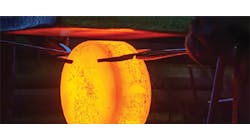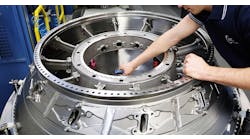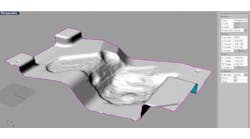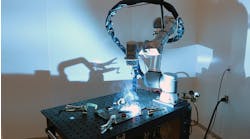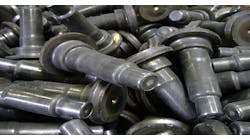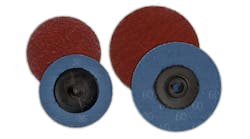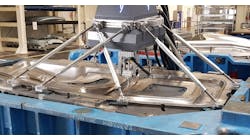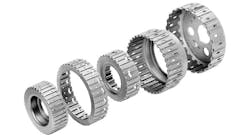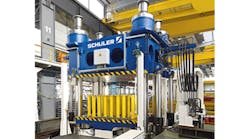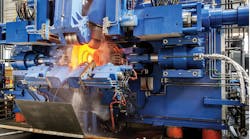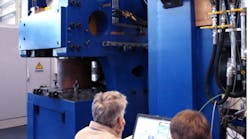Metal forming processes continue to reveal new insights to the engineers who study them and the operators who manage them, but there is another source of innovation: product designers who issue orders for new systems that require parts never produced or imagined before. Even now, automakers’ quick rush to new drivetrain systems is putting pressure on Tier 1 suppliers to deliver an entirely new class of component parts.
Automakers are adopting eight-, nine-, and even 10-speed transmissions in order to reduce fuel consumption without foregoing the horsepower that drivers expect in performance and luxury vehicles.
Feintool U.S. Operations, a manufacturer of drivetrain parts like clutch plates, disc carriers, planetary carriers, pistons, drive plates, and guide discs, and various others, recognized the challenge to engage in some design innovation of its own.
The Nashville manufacturer started as a greenfield operation in 1999, supplying the domestic automotive market with fineblanked and formed components. Those are specialty processes for the Swiss company, and the U.S. operation gained a broader market share over the following decade. The plant manufactures dozens of different formed parts, in increasing volumes, for different automotive platforms.
Problems emerged with the introduction of the new drivetrain technologies. As outlined by Lars Reich, Feintool U.S. Operations v.p. - Sales & Marketing, automotive designers’ weight-saving efforts — themselves driven by fuel-saving objectives and tightening emissions regulations — have resulted in automatic transmissions that are remarkably more efficient than in the past, even more efficient than standard transmissions.
However, using more gear stages to control vehicle power more effectively requires the transmission builders to place an increasing number of parts in (essentially) the same space. Thus, the manufacturers of those parts must produce higher volumes of plates, discs, carriers, etc. that demonstrate even greater dimensional accuracy.
“There are thin steel parts that have a high tensile strength to endure the RPMs being generated, and they have to hold up to the torque and every other stress — and still be light, and conserve space,” according to Reich. He noted that Feintool U.S. is now producing about 15 different formed parts for such applications, in addition to 45-50 different fineblanked clutches plates.
Fineblanking is a process that simultaneously compresses and shears sheet metal in order to reduce the amount of tearing along the edge. The results are blanks with neatly defined shapes and edges that are completely smooth.
But, the new production demands meant Feintool U.S. needed a more powerful and more flexible process line. What followed was a 26-month design, development, and construction process by Feintool and Schuler Group, the result of which is the customized 1,600-ton direct servo press that started operating at the Nashville plant in March.
Design, Development Combines Expertise
The estimated $14-million project combined the expertise of both companies, but some additional time in the early phases of the project was required to define the possibilities and the necessities. Also, the final design — the Fineblanking & Forming System (FFS™) — is a machine of such impressive scale (an 18-ft-long working bed, a foundation to house the hydraulic power unit) that it could only be assembled on site. That extended the project, too, Reich noted. In fact, as of mid-April Schuler technicians were still on the scene in Nashville, fine-tuning the FFS control software and other details.
Along the length of that 18-foot press table, the FFS combines advanced servo drive capability with a three-axis transfer system, so that the forming sequence achieves a greater degree of dimensional accuracy.
Mild carbon and HSLA steel blanks ranging from 10 to 18 inches in diameter, are processed along the narrow, 18-ft table. There are up to 12 process stations available, Reich emphasized, with a 500-mm progression. A CNC-driven transfer system places each slug into each process station, completing what he characterized as a series of deep-drawing processes.
“We also use in-tool roller technology,” he said. “It draws the tooth profile through two to three stations — a pre-roll, a roller, and a calibrating station – and that eliminates the Grob (cold forming) process.”
The flexibility of the FFS process allows Feintool U.S. to form and finish disc carriers, pistons, gear spiders, and driveplates, among other parts, in a single transfer-press run.
Providing the power for FFS is a hydraulic unit adapted from a 700-ton fineblanking press and installed in the foundation level of the new line. It delivers high volumes of oil at precisely controlled ram positions and pressures, so that multiple fineblanking operations of the forming tools are performed at different transfer stations in a fully integrated production effort.
Beyond Standard Limitations
The specific configuration derived for FFS eliminates one standard limitation of fineblanking, that of having a relatively small bed size. And, by adding more hydraulic power, FFS established the opportunity of combining fineblanking stations with a transfer press. The results are the flexibility, throughput, and precision that Feintool U.S. required.
The three-axis, CNC-controlled transfer system guarantees smooth progress for each workpiece as it proceeds through the tooling stations. The controls maintain the positional accuracy and speed that are essential for optimizing the stroke rate capabilities of the direct drive servo press, and maintaining the accuracy of the forming process.
Another important design feature of the FFS is a moving bolster that allows quick die changes — within 20-30 minutes. The servo press has two moving bolsters operating in alternation, moving from the front of the press to the back. The entire tool can be set-up outside of the press on the spare moving bolster, including the transfer arm and all the sensors for parts detection. When the moment arrives to carry out a tool change, the moving bolster is placed in position and the machine is ready to resume forming transmission parts, with only a minor pause in throughput.
“The start of the production with the new servo press line relieves immediate capacity constraints for our customers and allows for future growth,” according to v.p. - Operations, Mark Stowe.
Some parts exiting the line will be processed further, including center-turning to produce bores, and all parts are processed through tumbling sequence to ensure they are properly deburred.
The FFS line is likely to be duplicated, Lars Reich predicted, but next up will be a new, 880-ton fineblanking press for clutch brake parts. That will be housed in a new addition to the Nashville plant, and start up later this year.
